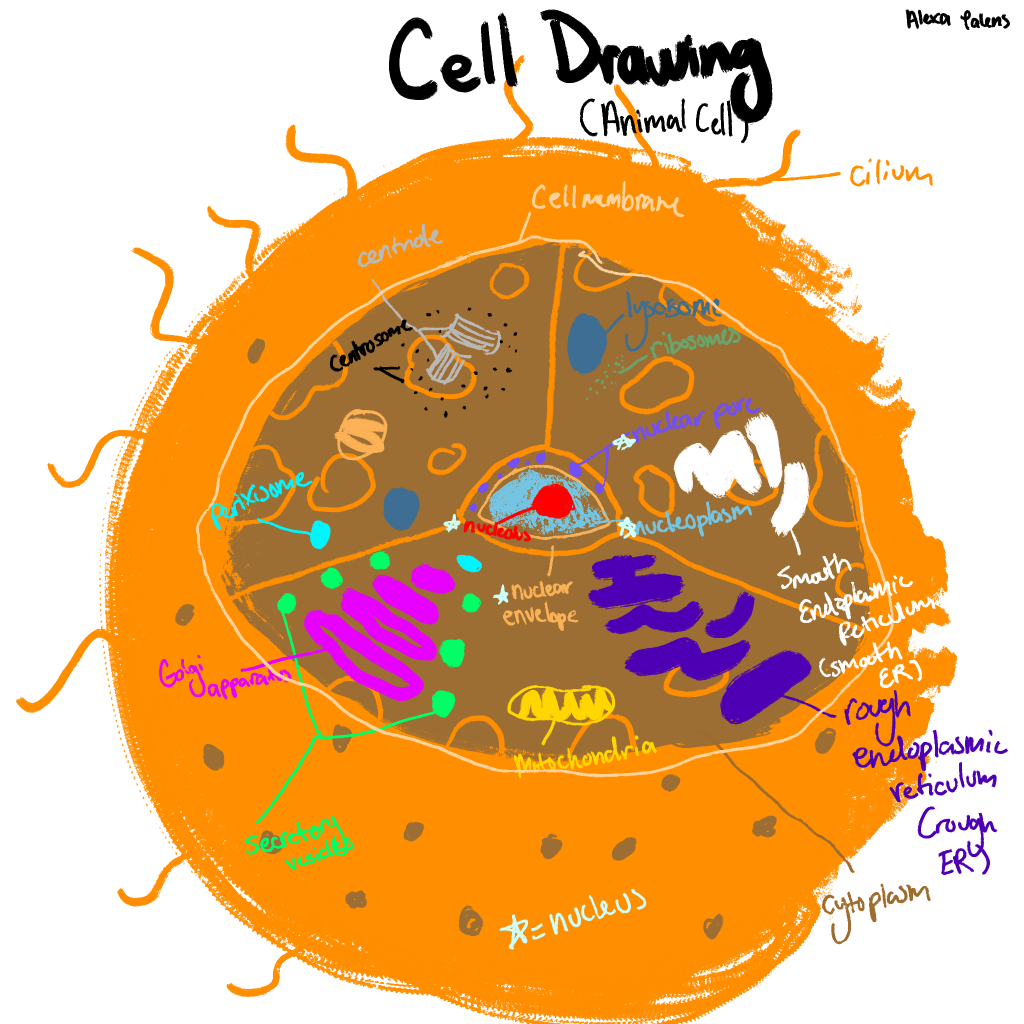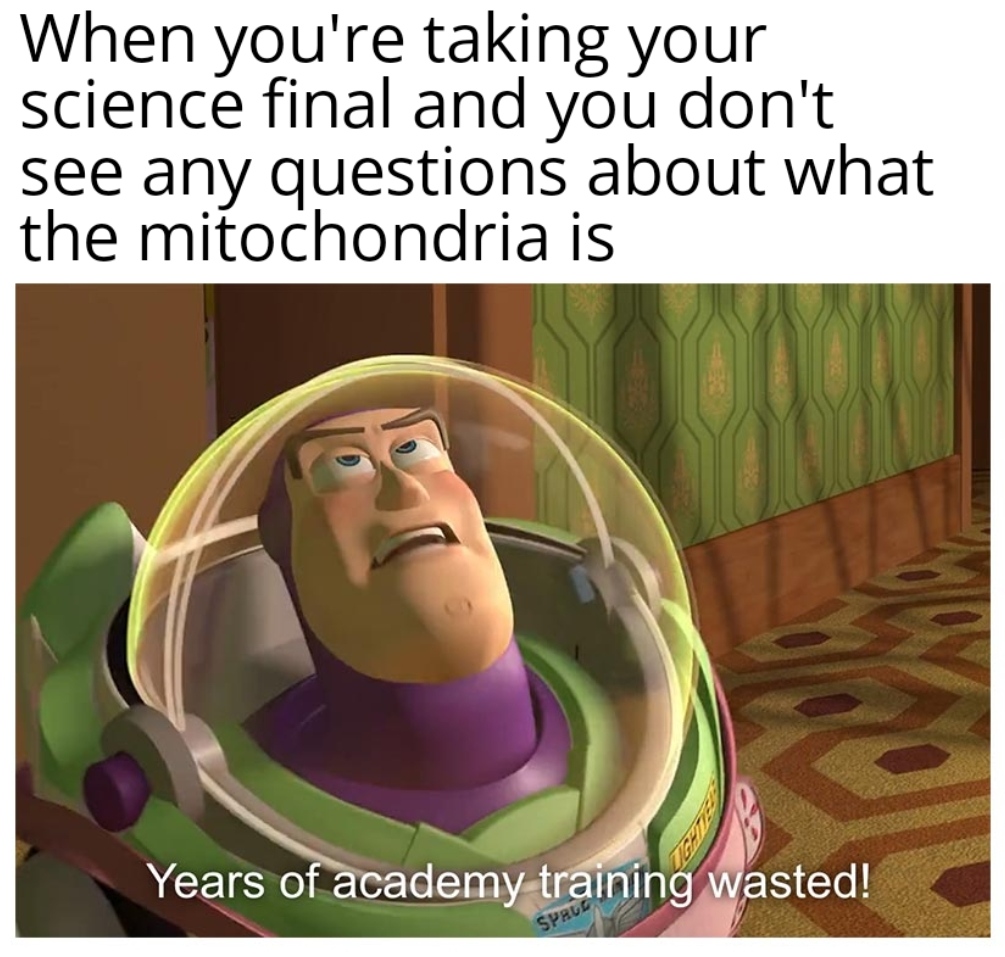Hello,
My name is Alexa Talens and I am currently studying at Old Dominion University for a Biology degree. I am aiming to complete my degree within a few years and hoping to gain some knowledge from this Cell Biology course. My current goal is to be able to pass my courses this semester and retain some knowledge from these courses.
Drawing of a Cell

Drawing of a Biomolecule

Find me a Meme

Scientific Literacy Essay
Alexa Talens
Dr. Steel
BIOL293
21 October 2022
Scientific Literacy: Artificial Sweeteners
As humans, we crave sugar as it triggers dopamine to be released from your brain which gives you a pleasant feeling. This dopamine rush leads to you wanting more and more of it resulting in potential weight gain. With sugar being a contributing factor in several people, many have turned to artificial sweeteners as a way to satisfy their sweet tooth without the calories. These sweeteners achieve this effect by being indigestible which allows it to pass through the body.
Artificial sweeteners are sweeteners derived from synthesizing certain chemicals together in a lab. These sweeteners are usually tens to hundreds to times sweeter than natural sugar as well as possessing little to no caloric value. Some of these popular sweeteners include aspartame, sucralose, saccharin and stevia. Aspartame’s chemical structure is C14H18N2O5, sucralose’s chemical structure is C12H19Cl3O8, Saccharin’s chemical structure is C6H16CONHSO2, and stevia’s chemical structure is C44H70O23. These compounds consist of carbon, hydrogen, and oxygen as all carbohydrates do. However, they all contain varying amounts of each element as well as possessing one or two extra elements. Nitrogen, chlorine, and sulfur are some of these extra elements.
One benefit of artificial sweeteners is that it provides an alternative source of sweets for those with a low glucose tolerance. Glucose tolerance is the ability to break down and digest glucose. An impaired glucose tolerance could be a sign that one is diabetic. Sugar substitutes could help regulate blood sugar due to the fact that they do not require the body to break down and instead mostly pass through the digestive tract.
The consumption of synthetic sweeteners naturally results in these compounds interacting with the gut microbiome. The gut microbiome refers to the billions of bacteria living inside your intestines which break down your food and allows the food to be digested. Without your microbiome, you would be incapable of digesting and absorbing the nutrients from the food you eat.
Glucose tolerance influences the gut microbiota as the composition of the microbiome varies with the insulin resistance of the body. Having a low gluten tolerance usually results in a high insulin resistance as insulin is produced to move glucose to the body’s cells. With a low glucose tolerance, this results in insulin being present in the blood longer than it should be. According to a study by Wu. et, al. discussing the correlation between the gut microbiota and prediabetes/diabetes, the composition of the gut microbiome was skewed to encourage growth of bacterial pathways for biotin (vitamin B7) biosynthesis for individuals with a low gluten tolerance. There was also a reduction of bacteria which produce butyrate, a carboxylic acid which is the energy source for your colon.
The microbiome has shown some alterations from the introduction of certain artificial sweeteners, such as stevia, saccharin, and sucralose. In a study by Suez et. al., saccharin and sucralose were found to have altered the population of gut bacteria. Saccharin was also found to have altered the metabolic pathways linked to glucose tolerance and dysbiosis (imbalance in gut bacteria dealing with disease). Stevia was found to affect gut microbiota composition. Most artificial sweeteners have not been found to have a significant impact on the function of the microbiome however.
All of the artificial sweeteners were discovered to have influenced and interfered with the composition of the gut microbiome as well as the oral microbiome. In the study conducted by Suez et. al, the sweeteners affect the metabolic pathways linked to glycolysis as well as glycan degradation. Glycolysis is a metabolic process in which glucose is broken down into pyruvates. These pyruvates serve as the fuel for the citric acid cycle, which provides the energy for our cells to begin. Glycans serve multiple roles such as carrying information to proteins, providing structural integrity, and metabolizing energy (Gagneux, et. al, 2022) .
One specific type of glycan linked to oxygen modification that resides in mucin are called O-linked glycans. Mucin is a group of glycosylated proteins and is the most popular type of macromolecule within mucus. O-linked glycans within mucin facilitate the development of necessary intestinal flora. The consumption of artificial sweeteners directly impacts the health of your intestinal health as a result of interfering with the pathways for glycan degradation. In addition to compromising your gut health, since glycans serve a range of functions, your body’s ability for cell communication, digestive capabilities, and structural integrity are also at risk.
In order to more closely study the impact of artificial sweetener on gut health, the study by Suez et al colonized healthy mice with stool containing artificial sweetener. Saccharin and sucralose again were found to have the most potent impact on glycemic response, showing that glucose tolerance is affected. Saccharin showed to have the highest impact out of the four sweeteners tested. Mice that received a stool transplant from mice who had been ingesting artificial sweeteners over the course of 21 days showed a higher glycemic response than mice that just began ingesting said sweeteners. (Suez et al, 2022) There were no significant effects found from other treatment groups. After comparing the results between the human trial and mice trial, it was discovered that the results of the mice study closely reflected the results of the human study. This gives credence to the thought that artificial sweetener consumption can be correlated to the glycemic response of the body.
The research conducted in the study by Suez et al proves that there is a correlation between the consumption of artificial sweeteners and glucose intolerance. The research conducted compared the glycemic response of the experimental subjects from when they first began consumption and 21 days later, where the body has had prolonged exposure to the substance. After 21 days, there was an increase in the glycemic response in the subjects. Fecal samples taken from subjects with prolonged exposure to artificial sweeteners were transplanted into unexposed individuals. These subjects also showed an increase in their glycemic response.
Personally, I am not against consuming artificial sweeteners at all. I think they are great for people who crave sweetness but are trying to watch their calorie intake. Drinks made with regular sugar are usually quite calorie-dense which makes it hard to stick within a specific calorie budget. Drinks made with artificial sweeteners are a good substitute for this reason. Individuals with pre-diabetes/diabetes also do not have to worry about their glucose levels when consuming food using them. However, I think the results of this study which show that artificial sweeteners having a significant effect on glucose tolerance would affect my future choices in food. Those who are particularly health conscious may stray away from consumption of any artificial sweeteners entirely. I would recommend erythritol because I personally enjoy the taste and do not suffer negative side effects from it. Everyone is different however and has their own tastes and responds differently to different substances.
References
Aspartame (no date) National Center for Biotechnology Information. PubChem Compound Database. U.S. National Library of Medicine. Available at: https://pubchem.ncbi.nlm.nih.gov/compound/Aspartame (Accessed: October 21, 2022).
Gagneux, P., Hennet, T. and Varki, A. (2022) Chapter 7 Biological Functions of Glycans, National Library of Medicine . National Library of Medicine. Available at: https://www.ncbi.nlm.nih.gov/books/NBK579984/ (Accessed: December 12, 2022).
Gershenson, G. (2017) A brief and bizarre history of artificial sweeteners, Saveur. Available at: https://www.saveur.com/artificial-sweeteners/ (Accessed: October 21, 2022).
Kaputk (2022) What is butyrate and what can it do?, Cleveland Clinic. Cleveland Clinic. Available at: https://health.clevelandclinic.org/butyrate-benefits/ (Accessed: October 21, 2022).
Low-calorie sweeteners (2022) The Nutrition Source. Available at: https://www.hsph.harvard.edu/nutritionsource/healthy-drinks/artificial-sweeteners/ (Accessed: October 21, 2022).
Pros and cons of artificial sweeteners (2020) Mayo Clinic. Mayo Foundation for Medical Education and Research. Available at: https://www.mayoclinic.org/healthy-lifestyle/nutrition-and-healthy-eating/in-depth/artificial-sweeteners/art-20046936 (Accessed: October 21, 2022).
Robertson, R. (2017) Why the gut microbiome is crucial for your health, Healthline. Healthline Media. Available at: https://www.healthline.com/nutrition/gut-microbiome-and-health (Accessed: October 21, 2022).
Ruiz-Ojeda, F.J. et al. (2019) Effects of sweeteners on the gut microbiota: A Review of Experimental Studies and Clinical Trials, Advances in nutrition (Bethesda, Md.). Oxford University Press. Available at: https://www.ncbi.nlm.nih.gov/pmc/articles/PMC6363527/ (Accessed: October 21, 2022).
Saccharin (no date) Saccharin – an overview | ScienceDirect Topics. Available at: https://www.sciencedirect.com/topics/biochemistry-genetics-and-molecular-biology/saccharin#:~:text=Saccharin%20is%20a%20synthetic%2C%20white,550%20times%20sweeter%20than%20sugar. (Accessed: October 21, 2022).
Shelton, P. (no date) Gut microbes and gluten: Your bacteria might be gluten-sensitive, Cell Science Systems. Available at: https://cellsciencesystems.com/education/news/gut-microbes-gluten-sensitive/ (Accessed: October 21, 2022).
Stevia powder (no date) National Center for Biotechnology Information. PubChem Compound Database. U.S. National Library of Medicine. Available at: https://pubchem.ncbi.nlm.nih.gov/compound/Stevia-Powder#:~:text=Stevia%20Powder%20%7C%20C44H70O23%20%2D%20PubChem (Accessed: October 21, 2022).
Stevia powder (no date) National Center for Biotechnology Information. PubChem Compound Database. U.S. National Library of Medicine. Available at: https://pubchem.ncbi.nlm.nih.gov/compound/Stevia-Powder#:~:text=Stevia%20Powder%20%7C%20C44H70O23%20%2D%20PubChem (Accessed: October 21, 2022).
Sucralose (no date) National Center for Biotechnology Information. PubChem Compound Database. U.S. National Library of Medicine. Available at: https://pubchem.ncbi.nlm.nih.gov/compound/Sucralose#:~:text=Sucralose%20is%20a%20disaccharide%20derivative,xenobiotic%20and%20a%20sweetening%20agent. (Accessed: October 21, 2022).
Sugar substitute (2022) Wikipedia. Wikimedia Foundation. Available at: https://en.wikipedia.org/wiki/Sugar_substitute (Accessed: October 21, 2022).
Wu, H. et al. (2020) The gut microbiota in prediabetes and diabetes: A population-based cross-sectional study, Cell Metabolism. Cell Press. Available at: https://www.sciencedirect.com/science/article/pii/S1550413120303120#:~:text=They%20showed%20that%20the%20gut,in%20prediabetes%20and%20T2D%20groups. (Accessed: October 21, 2022).